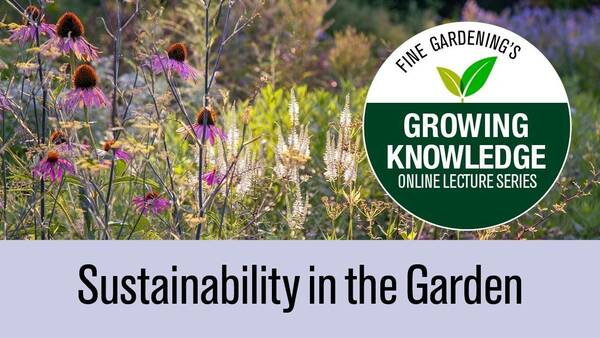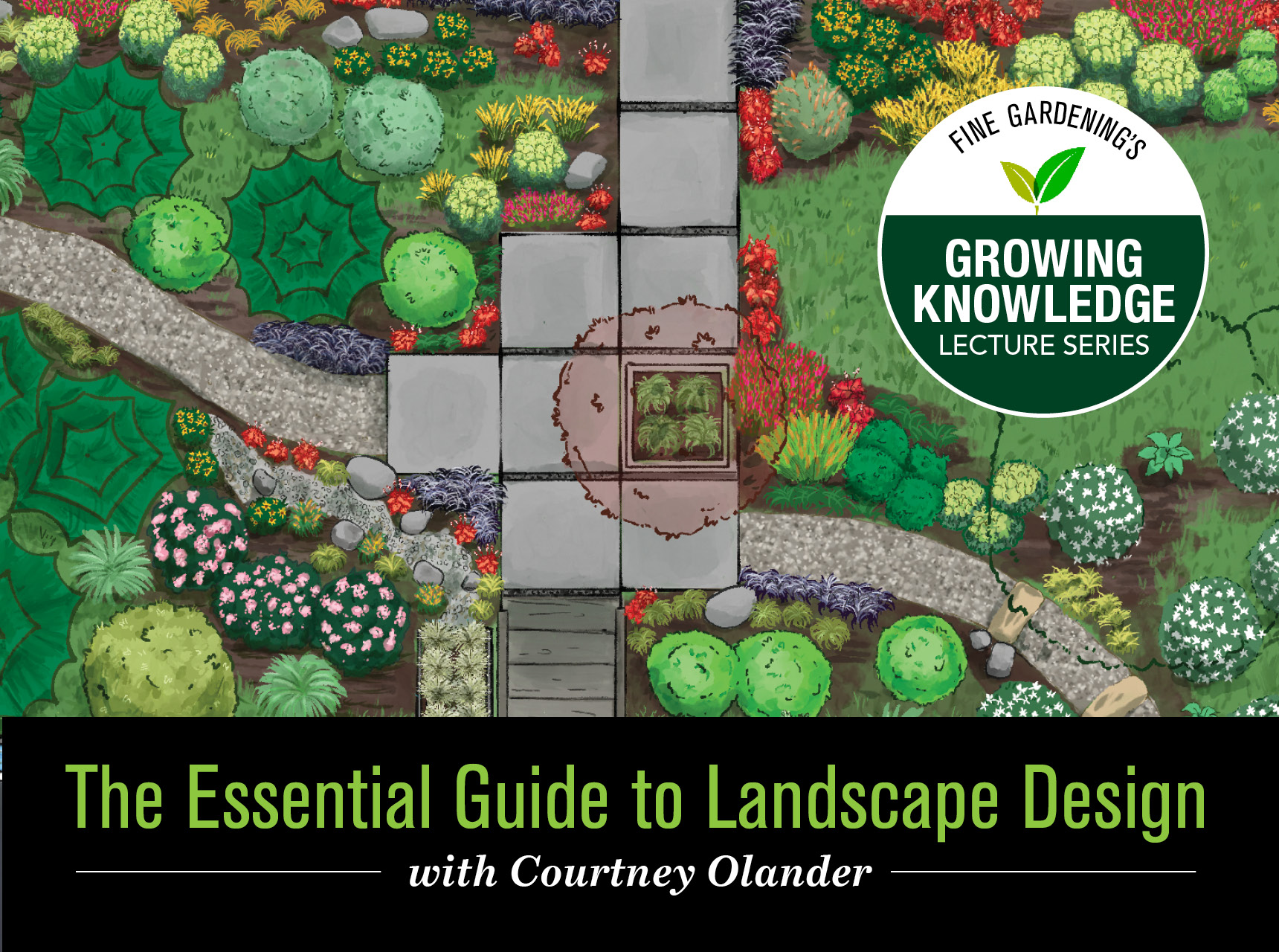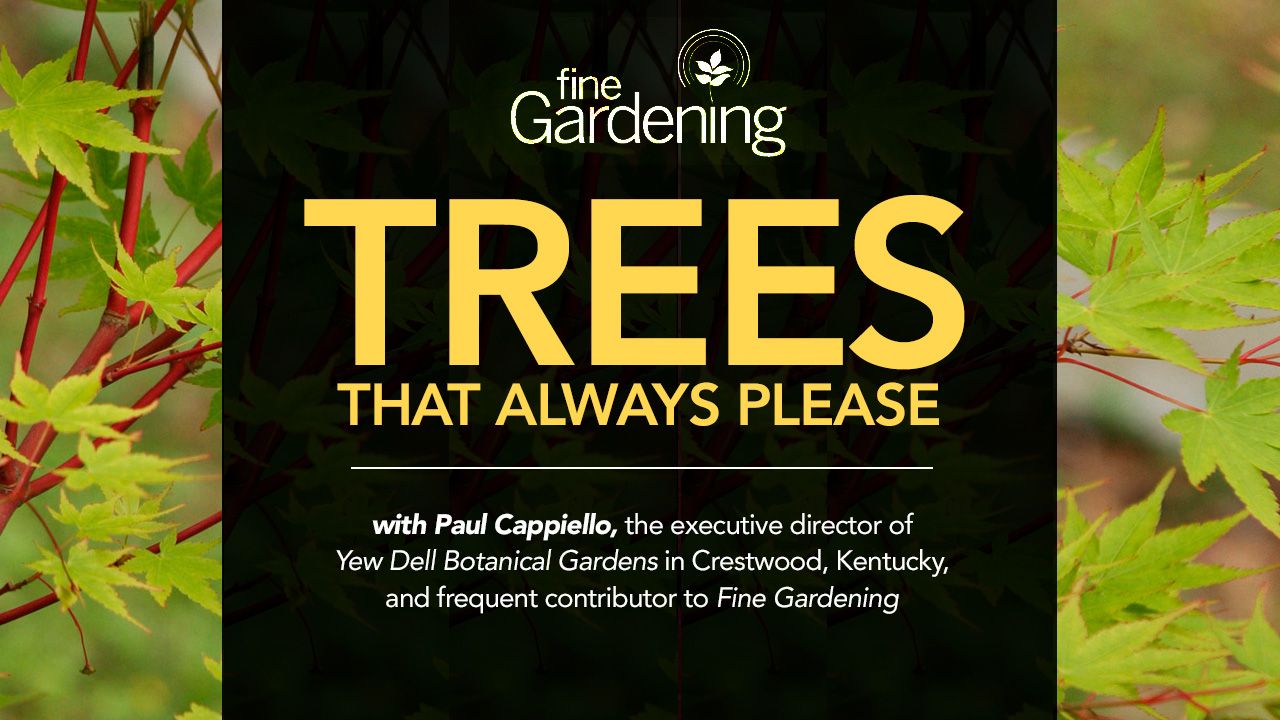
Trees That Always Please
Trees are a big investment. This isn’t only because they often have a hefty price tag, but also because they take up a lot of garden real estate and aren’t plants that you’ll be able to readily relocate. When choosing a tree, it’s important to make sure it performs in all four seasons. It shouldn’t just have lovely spring blooms and decent fall color. It should also have winter interest and other noteworthy traits that shine when it’s not at its peak. And a tree should be largely pest- and disease-free, with low needs when it comes to care. After all, who wants to invest in a plant that will require 50 years of high maintenance?
Woody plant expert Paul Cappiello understands these requirements well. As executive director for the Yew Dell Botanical Gardens in Crestwood, Kentucky, he is constantly evaluating the pros and cons of trees. And on his plant travels around the world, he’s always keeping an eye out for trees that are exceptional in myriad ways. For this presentation, Paul reached out to several of his horticultural friends and colleagues to provide you with a list of incredible trees that you will never regret planting. Whatever you choose, it will be one of the best garden investments you’ll make.
About the Presenter
| Paul Cappiello is executive director of Yew Dell Botanical Gardens in Crestwood, Kentucky. Paul is a woody plant expert, frequent Fine Gardening contributor, and author of Dogwoods, the definitive guide on North America’s most beloved tree. When Paul isn’t giving lectures across the country, you’ll find him traveling extensively to the world’s most incredible gardens. And his wit almost surpasses his horticultural knowledge.
|
 |
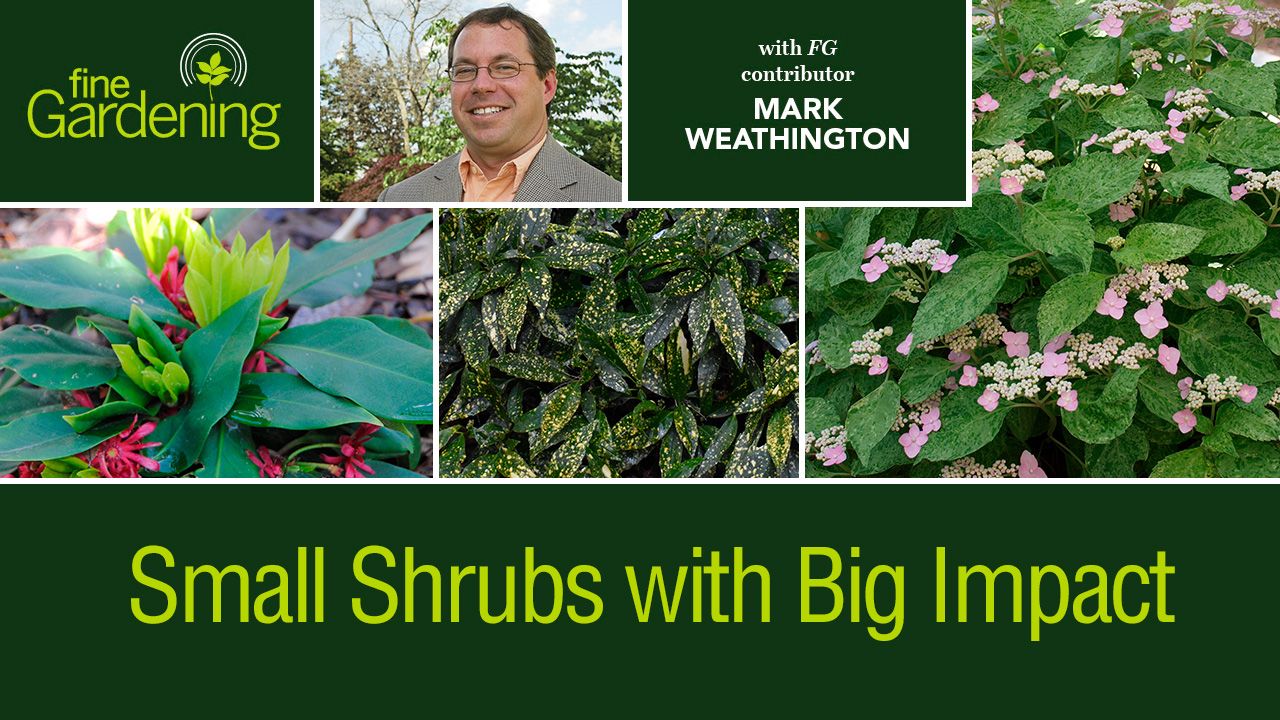
Small Shrubs with Big Impact
Many modern landscapes are small. The amount of space we have to garden is shrinking, as people want the blend of suburban life along with the conveniences of city living. Even where space might be available, a lot of avid gardeners still have other interests and obligations, leaving less time to cultivate a large plot. When space and time are at a premium, turning to small shrubs can be the answer. In this webinar, Mark Weathington, director of the acclaimed JC Raulston Arboretum in North Carolina, will share some of his top shrub picks for creating diversity, interest, and excitement where space is limited and every plant must earn its place in the garden.
About the Presenter
| Mark Weathington is the director of the JC Raulston Arboretum at NC State University. He earned undergraduate degrees in both horticulture and sociology and a master’s degree in horticulture from Virginia Tech. He has served as director of horticulture for the Norfolk Botanical Garden and horticulturist for the Atlanta Botanic Garden. Mark travels extensively searching for new plants to diversify the American landscape. His explorations have taken him to China, Taiwan, Japan, Ecuador, Europe, Mexico, New Zealand, and throughout the United States. Mark writes and speaks on a variety of topics in horticulture. He is the author of Gardening in the South: The Complete Homeowner’s Guide from Timber Press. He has been published in Horticulture, Carolina Gardener, American Nurseryman, and VA Gardener magazines as well as The Mid-Atlantic Gardener’s Book of Lists. |
 |
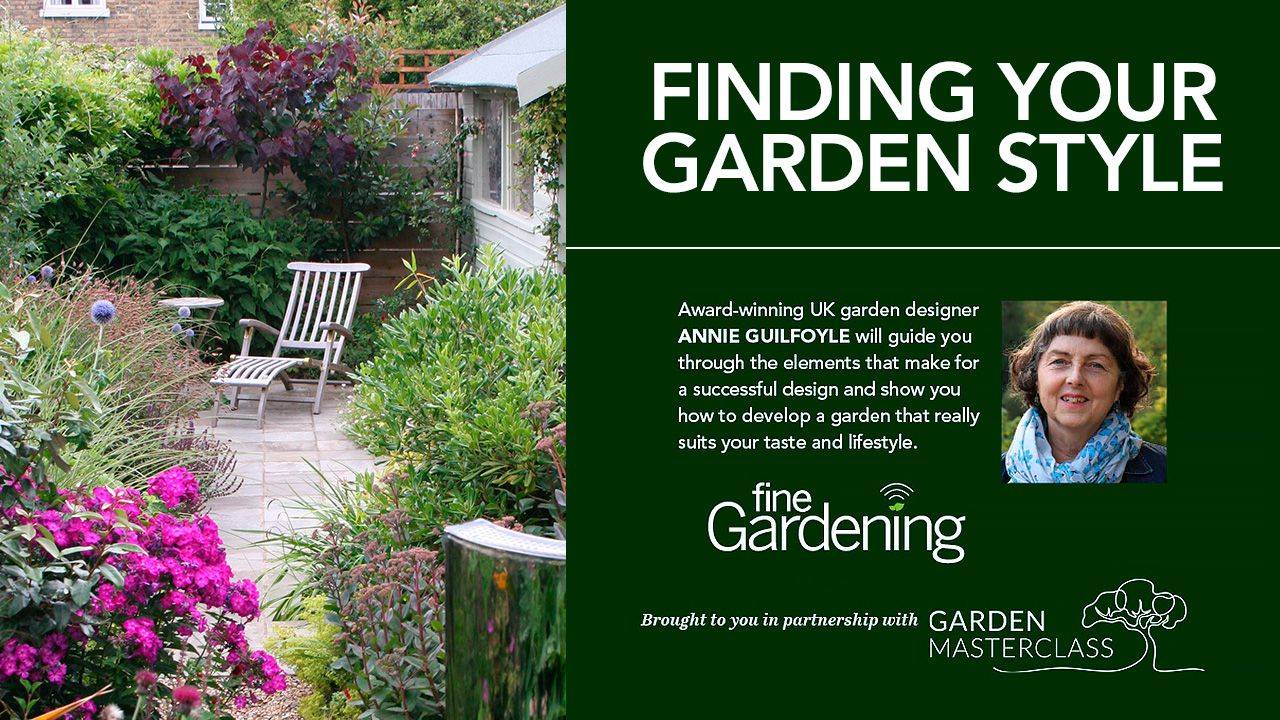
Finding Your Garden Style
How do you begin the process of designing or refining your own gardens, especially when there are so many things that you need to take into consideration? In this class, award-winning UK garden designer Annie Guilfoyle will guide you through the elements that make for a successful design and show you how to develop a garden that really suits your taste and lifestyle. This webinar will focus on how to use sketching and observation as tools to develop your technique. The process of designing your space should be fun, according to Annie, so she’ll share insights for how to develop your style using the influences of things you really like, such as textiles, art, and architecture. There will be plenty of suggestions on how to start your design process and gather inspiration—and, of course, we will touch on those oh-so-important plants.
*If you are interested in classes similar to this, please join us for a three-part course, Garden Ideas That Work, which will offer a deeper dive into the garden design process. This unique set of classes will be taught by a trio of renowned UK landscape designers.
About the Presenter
| Annie Guilfoyle is an award-winning designer and an RHS Chelsea Flower Show Silver Medal winner. After studying horticulture at Capel Manor College in Enfield, Middlesex, she earned a BA Honours Degree in garden design from Middlesex University. Annie combines running a successful garden design consultancy with lecturing and writing on the subject. Annie’s design work has featured on several television programs, including Small Town Gardens on the BBC.
For 18 years Annie was the director of garden design at KLC School of Design at Hampton Court Palace, Surrey, where she was instrumental in establishing the highly acclaimed garden design courses. Many of Annie’s students have gone on to become award-winning designers.
As garden course consultant at West Dean College near Chichester, West Sussex, Annie is responsible for the development of the educational program and has developed an educational allotment where students can learn about growing food. Annie also teaches a monthly course called The Art and Craft of Garden Design at Great Dixter House and Gardens.
|
 |
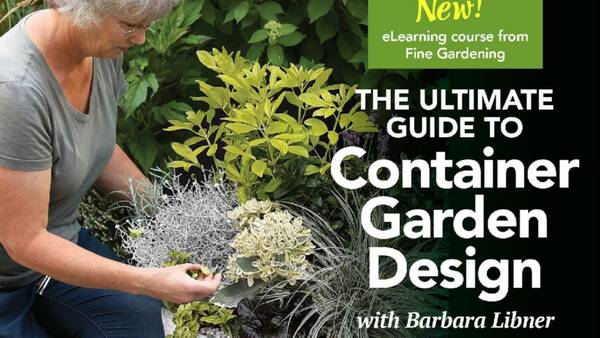
The Ultimate Guide to Container-Garden Design
If you are ready to take your container design to the next level, join us for this course with Barbara Libner, who has been designing stunning containers professionally for over two decades. Barbara will walk you through every step of creating the perfect container as she shares her tips and techniques for better plant combinations, including numerous examples from her own designs and recipes you can follow on your own. Explore the concepts of color, texture, balance, and repetition as you learn to transform your own containers from ordinary to extraordinary. You can view each class on demand and then dive into an online forum where you can share ideas with other course participants and get your questions answered by Barbara herself.
In this course, you will learn how to:
- Determine what kind of approach is right for your space and your aesthetic
- Choose a container with the best color and material for your space
- Develop a planting color scheme that thrills
- Get the most bang for your buck when shopping for plants
- Choose between seasonal or year-round interest
- Get your plants off to the best start when planting
- Maintain your creation for maximum longevity
- Plan for seasonal swaps to keep the show going
Lesson 1
This initial class will get you familiarized—or refreshed—on the basics of designing a container garden. Barbara will cover why it’s aesthetically important to add containers to your garden and how you can use them to improve your landscape and/or complement your home. She will also dig into choosing the best containers and soil mixes and will explain how to assess the conditions in your garden that will determine what plants will thrive in your containers.
Lesson 2
Have you always wondered why the container gardens in magazines look so much better than the ones you create at home? In this class, Barbara will share the secrets to putting plants together for incredible visual appeal. She will cover choosing color palettes, ways to add contrast and interest, and how to use foliage to maximize the composition’s impact. Finally, all that theory will be put to practical use with Barbara’s special formula for the perfect container: the Fabulous Five.
Lesson 3
This class will teach you how to keep your containers looking stunning for months by choosing the best plants and caring for them as they grow and develop. Barbara will also cover the best ways to embrace seasonality—how to choose plants for multiseason interest and how to swap out plants in a cost-efficient manner. Barbara will also cover features that keep a container looking beautiful every month of the year (yes, even in winter).
About the Presenter
Barbara Libner accidentally turned a lifelong passion for plants and design into a career when a seasonal nursery job became a full-time, decades-long journey of botanical discovery. She specializes in four-season containers for an array of different climates. When not designing containers or being a general plant nerd, she is the lead visual merchandiser for Ravenna Gardens, an independent urban garden center in Seattle. Barbara is a true artist who works with color, texture, and habit to craft potted masterpieces. Her background in art history has trained her to identify and accentuate certain design elements, prioritizing the form of each plant she works with over its color. In fact, if you ask Barbara, it’s the juxtaposition of the different types of foliage in a container planting that gives it long-lasting appeal.
Register Now!
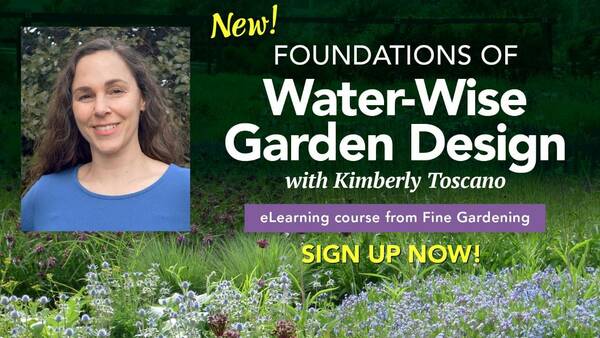
Foundations of Water-Wise Garden Design with Kim Toscano
It’s easy to feel helpless in the face of unprecedented drought, water restrictions, and soaring temperatures—but we gardeners are not powerless. With careful planning we can create beautiful, drought-resilient gardens that thrive no matter what the weather may bring. And by applying water-conservation techniques in our backyards, we not only lessen our dependency on supplemental water but also help to preserve and protect natural waterways downstream.
In this online course, you will learn how to make the most of rainfall by implementing strategies that keep rainwater on-site. You will discover ways to minimize the need for supplemental irrigation while building drought resiliency in the landscape. The lessons learned will give you the confidence to create sustainable spaces in your yard, whether you are landscaping a newly built house or renovating an older garden.
Topics covered include:
- Understanding and managing your soil type
- Making the most of rainfall
- Planning efficient irrigation
- Dealing with watering restrictions
- Finding drought-resistant plants
- Choosing alternatives to water-hungry lawns
About Your Instructor
Kimberly Toscano is an accomplished horticulturist with an eye on design. Formally trained in horticulture, environmental science, and entomology, she is interested in all things edible as well as garden design and landscaping for wildlife. Kim takes a holistic approach to gardening and landscaping, working in harmony with the natural environment. This includes organic and sustainable gardening practices, careful management of water, and enhancing biodiversity in the landscape.
Before establishing a career in garden writing and consultation, Kim served as writer and host for Oklahoma Gardening, a weekly PBS television program produced by the Oklahoma Cooperative Extension Service. In this role, she shared her expertise through more than 1,000 video segments covering all aspects of gardening, environmental stewardship, and sustainable living. To support her programming, Kim designed over a dozen gardens that were installed at The Botanic Garden at Oklahoma State University, including a formal terrace, an organic vegetable garden, and themed ornamental plantings.
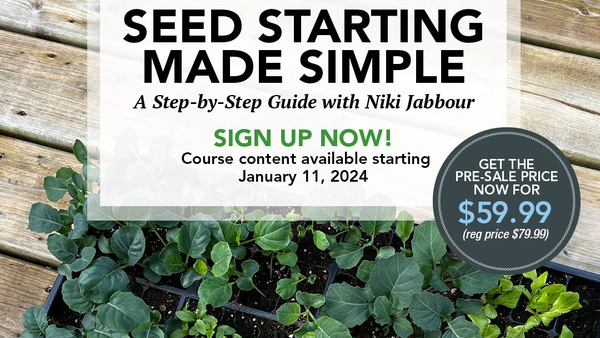
Seed Starting Made Simple: A Step-by-Step Guide with Niki Jabbour
Starting plants from seed opens a world of possibilities to gardeners of all skill levels. Many vegetables, annual flowers, and even perennial plants can be started from seed using a few basic supplies and easy-to-master techniques. This can be an economical way to fill garden space and enjoy a much wider variety of plants than you could find in any nursery. In this course, horticulturist Niki Jabbour will share tips and tricks from her decades of starting seeds. After covering the basics, she will delve into more advanced topics such as timing and stratification. Participants will learn about which tools and supplies the pros recommend to make seed-starting easier, and how to set up a simple DIY lighting system. Build your gardening skills and enjoy the satisfying feeling of growing plants from scratch with this fun, fast-paced course.
Learn more: The Science of Seed Starting
You’ll get advice on:
- Which seeds to start indoors versus outdoors
- How to get the timing right
- The ins and outs of building your own seed-starting setup
- In-depth lighting instructions (including LED insights)
- Mixing custom seed-starting soil mixes
- Hardening off and planting out
- Troubleshooting techniques for when things go wrong
Niki Jabbour is the award-winning author of four books:
The Year-Round Vegetable Gardener, Groundbreaking Food Gardens, Veggie Garden Remix, and
Growing Under Cover. She is a rare two-time winner of the prestigious American Horticultural Society Book Award and a frequent lecturer for various horticultural institutions around North America. Niki is a contributor to numerous publications, including
Fine Gardening. She was also the host and executive producer of a popular radio show,
The Weekend Gardener, for 15 years and is now the garden expert on Canada’s CBC Radio. When she’s not writing, speaking, or broadcasting about food gardening, Niki is harvesting vegetables year-round from her 3,000-square-foot urban garden in Halifax, Nova Scotia.
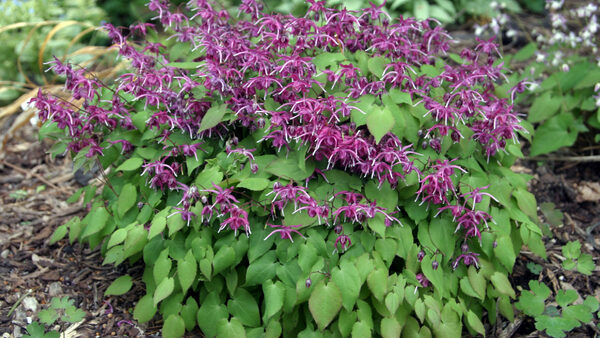
Flourishing in the Shade Garden with Ed Lyon
Shade is one of the largest challenges facing home gardeners—especially the novice and inexperienced—but even seasoned gardeners can struggle with it.
In this immersive online course, you will learn how to make the dark areas of your yard shine. Instructor Ed Lyon started his journey into ornamental gardening almost 30 years ago. Across that expanse of time, he owned four properties—all with shaded areas—so he was compelled to get serious about addressing shade issues to create display beds. He also became passionate about helping to educate other gardeners about succeeding in the shade.
What You Will Learn
In this course, you will learn how to build or improve a shade garden. In addition to providing guidance on design and how to select the right plants, Ed will share his broad experiences, including mistakes, to give you the knowledge you need to address the dark spots in your yard with confidence. Whether you are a new or experienced gardener, you will learn that throwing shade is a good thing in gardening.
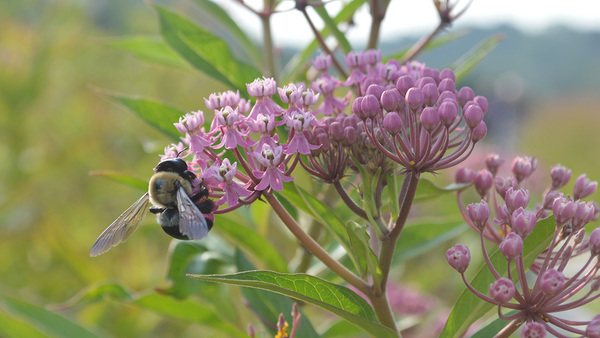
Plants for a Better Planet
Can plants really save the planet? The presenters of this three-part course think so. with Richard Hawke, Sue Milliken, Kelly Dodson, and Kelly D. Norris
Earth-friendly gardening practices focus on minimizing the negative impact that gardening can have on the environment. This can include using sustainable gardening techniques such as composting, reducing or eliminating the use of synthetic pesticides and fertilizers, and conserving water.
But it also means being incredibly selective about the plants you choose to use in your landscape. Planting native species, which are adapted to the local climate and soil conditions, is an important aspect of earth-friendly gardening. Using ornamental plants that are truly low-maintenance or provide valuable resources to wildlife is another option for gardening in a greener way. It’s also essential to the planet as a whole to protect rare and endangered species that are under threat in their native regions.Can plants truly save the planet? The presenters of this three-part course think so, and they will share exactly why and how they think you can help make that happen.
The course includes over 3 hours of video lessons.
Sustainability in the Garden
Join us as we take a deep dive into the complex and sometimes controversial gardening topic of sustainability. This on-demand lecture series features four separate classes related to the overall theme. Each highly engaging session is modeled after a college course and is taught by a leading expert in the field. With each class you’ll receive not only in-depth instruction but also informative handouts to help you understand and visualize the concepts being discussed. Each class is offered on-demand, so you can view it at your leisure.
Topics that will be covered include:
- Ideas for sustainable garden design
- Naturalistic approaches to landscape planning
- Native alternatives for common plants
- Pollinator-friendly selections for every region
- Habitat conservation at the backyard level
- Steps for enhancing soil sustainably
- Conditional improvements for successful native-plant integration

Garden Design Ideas That Work, with Garden Masterclass
Class 1: Reimagining the Mixed Border, Noel Kingsbury
The “mixed border” is arguably the unsung hero of planting design. Combining small trees, shrubs, perennials, climbers, bulbs, and even annuals has long been the mainstay of many of the best gardens in the world. A mixed border design provides the best opportunity for a long season of interest, and research has shown that it offers the best opportunities for supporting biodiversity, too. In this class we’ll look at the different elements of this blended style and how they can be brought together. Additionally, we’ll discuss layered plantings (in both a structural and seasonal sense) using a woodland edge habitat as a natural case study to reveal why this approach works both visually and ecologically. This planting method satisfies the love many gardeners have for truly making the most of plant diversity close to home.
Noel Kingsbury is internationally known as an innovator, writer, and teacher in the fields of gardening and planting design.
Class 2: The Herbaceous Design Process: Conception, Production and Refinement, Elliot Forsyth
Take an in-depth look at how to design, plan, lay out, and finesse perennial plantings. Your instructor, Elliot Forsyth, is known internationally for his skillfully designed and maintained perennial and seasonal plantings throughout Scotland and beyond. Here, he’ll explain how to use a sense of place to unpack a framework of design fundamentals and what the critical aspects are when formulating a planting plan. Elliott discusses the importance of a clear theme and demonstrates the method he employs to create it. Using specific examples, he takes you through a step-by-step process: exploring plant selection, combining plants effectively, and planning, laying out, and refining perennial plantings. This course will teach you how to create a concise and masterful exposition, using a detailed yet approachable process.
Elliott Forsyth is an experienced and creative horticulturist who specializes in naturalistic perennial design. He trained at the RHS Wisley, the Royal Botanic Gardens Edinburgh, and SAC Auchincruive.
Class 3: Planting the Smaller Urban Garden, Annie Guilfoyle
Planting smaller, urban gardens can sometimes be a really challenging and somewhat daunting task. What should you include and what is OK to leave out when space is very limited? In this class, award-winning designer and RHS Chelsea Flower Show Silver Medal winner Annie Guilfoyle will focus on the best way to research and select plants that will work in the smaller spaces while offering as much interest as possible. She’ll outline the importance of seasonal interest and offer concrete how-to advice, especially when designing front-facing gardens. Additionally, Annie will address often overlooked aspects in small-space gardening, like the inclusion of bulbs, which are a great way of packing interest into urban pocket gardens. And finally, you will get a tutorial on designing and drawing up a planting plan.
Annie Guilfoyle is an award-winning designer and an RHS Chelsea Flower Show Silver Medal winner.













